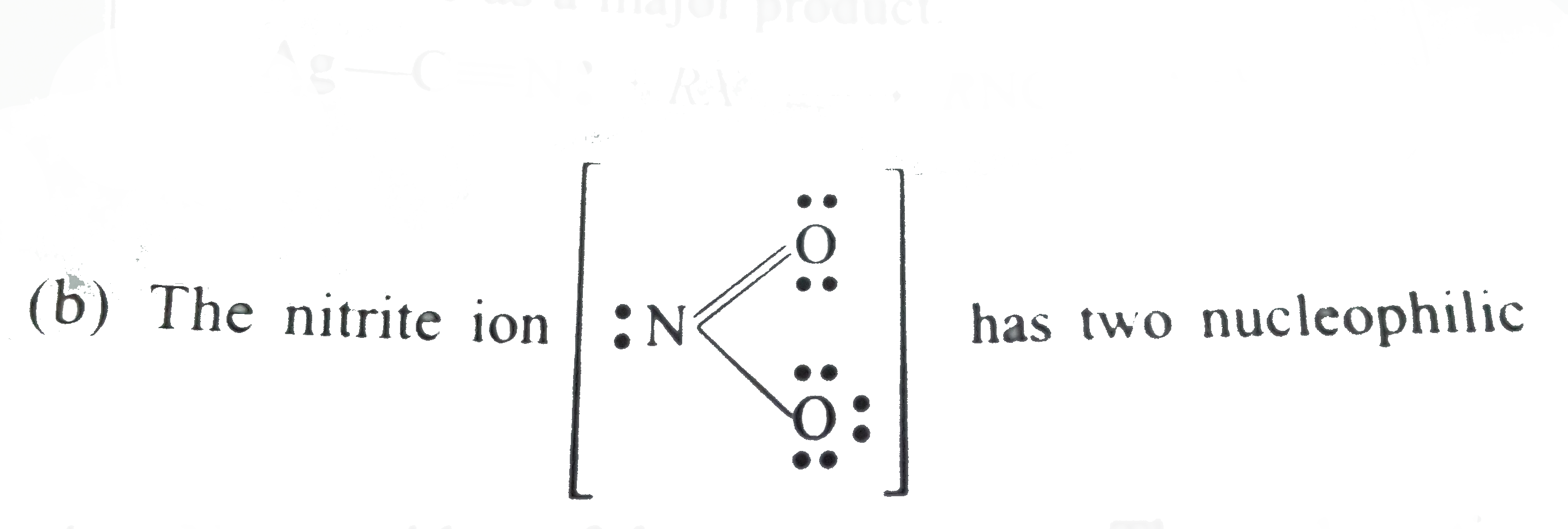Give reasons for the following:
(a) Potassium cyanide reacts with R -X to give alkyl cyanide. While silver cyanide forms an isocyanide as a major product.
(b) Silver nitrite reacts R-X to give a mixture of nitroalkane and alkyl nitrite.
(c) R-OH does not react NaBr but on adding H2SO4 . if forms R-Br.
(d) Alcohols do not undergo substitutionl in neutrol or alkaline solution.
Video Solution
Text Solution
(a) Potassium cyanide is an ionic compound  and provide cyanide ions in solution, in which each of carbon and nitrogen carry a lone pair of elctrons [CN is an ambident nucleophile(ligand)].
and provide cyanide ions in solution, in which each of carbon and nitrogen carry a lone pair of elctrons [CN is an ambident nucleophile(ligand)].
As lone pair on carbon is more reactive, the carbocation, R+, preferentially attacks the carbon atom and therby forms an alkyl cyanide predominantly.

On the other hand , AgCN (being insoluble) is a covalent compound and only nitrogen has the lone pair of electrons. ltbr> Thus, carbocation attacks through nitrogen and thereby forms an alkyl isocyanide as a major product.
Ag−C≡N:+RX→RNC:+AgX

sites i.e., N and either of the oxygen atoms . the carbocation can attack either N or O, thereby forming a mixture of nitroalkane R−NO2 and alkyl nitrite R−ONO.
(c) Br− ion is a very weak Bronsted base and thus it can not displace the strong base −OH− . When H2SO4 acid is added ,H+ are available which form +ROH2. Under this condition, Br− displaces H2O which is a very weak base.
+ROH2)+B−→R++H2O+Br−→RBr+H2O
(d) A leaving group must be a weak bse. The leaving −OH group of alcohols in neutral or alkaline solution would be stronger base, hence cannot be removed by weaker bases like CI−,Br−,I−.
|
Topper's Solved these Questions
- HALOALKANES AND HALOARENES Book:OP TANDONChapter:HALOALKANES AND HALOARENES Exercise:Problem For Practice
Explore 19 Videos
- HALOALKANES AND HALOARENES Book:OP TANDONChapter:HALOALKANES AND HALOARENES Exercise:Matching type
Explore 2 Videos
- HALOALKANES AND HALOARENES Book:OP TANDONChapter:HALOALKANES AND HALOARENES Exercise:illustrations of objective questions
Explore 10 Videos
- ELECTROCHEMISTRYBook:OP TANDONChapter:ELECTROCHEMISTRYExercise:Matrix-Matching Type Question
Explore 3 Videos
- ISOMERISM (STRUCTURAL AND STEROISOMERISM)Book:OP TANDONChapter:ISOMERISM (STRUCTURAL AND STEROISOMERISM)Exercise:INTEGER
Explore 7 Videos
Similar Questions
Knowledge Check
KCN reacts readily to give a cyanide with
AEthyl alcoholBEthyl bromideCBromobenzeneDChlorobenzeneAniline reacts with alkyl halide to give
AAmino compoundBTertiary compoundCQuaternary ammonium compoundDAzomethaneAlkyl iodides reacts with NaCN to form alkyl cyanides plus a little amount of alkyl isocyanides. The reason for the formation two types of products is-
AIonic character of NaCNBNucleophilic character of cyanide ionCAmbident character of cyanide ionDElectrophilic character of cyanide
Alkyl iodide react with NaCN to give alkyl cyanide and small amount of alkyl isocyanide. Formation of these two product is due to the
View SolutionAlkyl halide and silver nitrite produces.
View SolutionDipole moments of alkyl cyanides and alkyl isocyanides are related as
View SolutionAlkyl cyanides can be obtained by
View SolutionAn alkyl halide reacted with a metal cyanide to give an alkanenitrile. The metal cyanide is -
View Solution

